1.How do we have seasons?
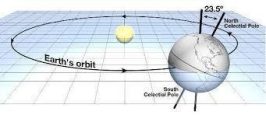
Many people believe that the earth’s distance from the sun causes summer and winter because the earth is closer to the sun in summer and farther from the sun in winter.
Although the idea makes sense, it is incorrect.
It is the earth’s (23.5) degree tilt, which plays an important part in changing the seasons.
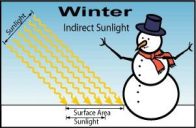
The north pole of the earth is always pointing the same direction i.e
Polaris (North star) as it goes around the Sun, therefore different parts of the earth receive different amounts of heat and light, which makes it hotter and colder in different times of the year.
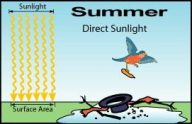
In winter sunlight passes through an angle and travels a long distance through the atmosphere to reach earth’s surface, while in summer the sun directly shines on the earth’s surface ,travel short distance through the atmosphere or passes through fewer atmospheres to reach the earth.
Earth revolves around the Sun once every 365.25 days. (0.25 days is adjusted in leap years, which has 366 days instead of 365 days. In leap year February has 29 days instead 28 days. Leap year is a year divisible by 4 and occurs after every 4 years)

When the north Pole is pointing toward the Sun, the sunlight hits the north pole directly because the Sun is above. The days are longer and nights are shorter.
With longer days the northern hemisphere heats up more and gets summer.
After six months, the North Pole is pointing away from the Sun. The northern hemisphere gets less sunlight because sun rays hit the north hemisphere from low level, the days are
shorter, nights are longer and it gets winter.
Note: All images are the same as in all images the the north pole is pointing towards the north star.
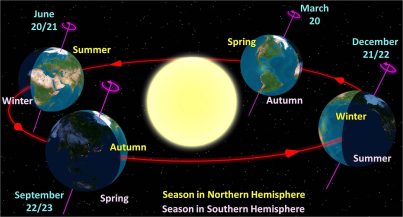
When the Northern Hemisphere is tilted towards the Sun is known as the Summer Solstice. And when it’s tilted away from the Sun, that’s the Winter Solstice. When both hemispheres receive equal amounts of energy, it’s called the Equinox. We have a Spring Equinox, and then an Autumn Equinox, when our days and nights are equal in length.

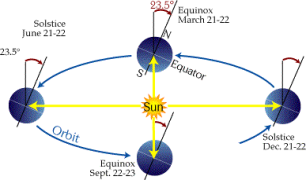
There are two days a year where the day and night are exactly the same. These are September 23th and March 21st.
In the Northern Hemisphere the longest day is on June 22nd while the longest night is on December 22nd. It’s just the
opposite in the Southern Hemisphere where the longest day is December 21st and the longest night is June 21st.
The hemispheres experience opposite seasons at all times.
Look at this natural phenomenon ! How do we have 4 different seasons in a year due to 23.5 degree tilt of the earth.
Q. Is it a Chance or Choice?
2. How do we have days and nights?
Rotation is the movement of earth around its axis. The earth’s axis is an imaginary line that runs through the earth center from one pole to the other. It is slanted at a 23.5 degree angle. One rotation of the earth around its axis takes roughly 24 hours. We call these 24th hours as “One day”. During these 24 hours, the sun seems to stay at the spot the entire time (actually not).
It is the earth’s rotation of earth from west to east that is responsible for the rising and setting of the sun. Days and nights are caused by earth’s rotation on its axis.
As viewed from the North star, the earth turns counter clockwise. Earth rotation is pretty short (one day) and the revolution is quite a bit longer 365 days (one year).
Q. Is it a Chance or Choice?
Zia Ahmed Khan, email: khanziaahmed50@gmail.com